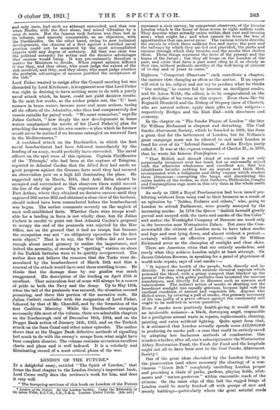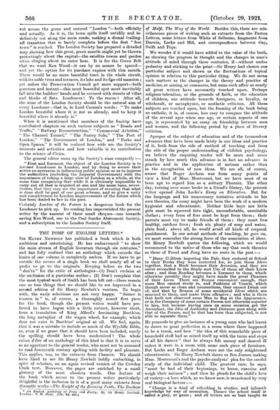LONDON OF THE FUTURE.*
In a delightful essay, entitled " The Spirit of London," that forms the final chapter to the London Society's important book, Lord Crewe really does the reviewer's work for him, and does it very well.
" The foregoing sections of this book on London of the Future • Loudon of the Future. By the London Society. Under the Editorship of Sir Aston Webb, ILC.V.O., C.13., P.B.A. London : Fisher Unrrin. [42r. net.] represent a civic survey, by competent observers, of the Greater London which is the home of from seven to eight million souls. They describe what actually exists within that vast and teeming area ; what might be ; and what cannot be from the loss of opportunities that can never recur. The various writers describe the streets in which these millions live and move, the port and the railways by which they are fed and provided, the parka and squares through which they breathe and the smoke that chokes them. These things represent the facts of the present and the hopes of tho future ; but they all hinge on the London of the past, and cities that have a past must cling to it as closely as they can, without pedantic sacrifice of the well-being of citizens of to-day and of years to come."
Eighteen " Competent Observers " each contribute a chapter, the manner thus changing as often as the matter. If an expert will stick to his subject and not try to produce what he thinks " fine writing," he cannot fail to interest an intelligent reader,
and Sir Aston Webb, the editor, is to be congratulated on the good discipline of his team in this respect. Even those like Sir
Reginald Blomfield and the Bishop of Stepney (now of Chester), who are natural writers, apply their gifts to their subjects—
respectively Bridges and tho East End—with directness and economy.
In the chapter on " The Smoke Plague of London " the late Sir William Richmond is eloquent and disturbing. The Coal Smoke Abatement Society, which he founded in 1899, has done a great deal for the betterment of London, but Sir Williams great campaign must not be allowed to end until London is freed for ever of its " Infernal Smoak," as John Evelyn justly
called it. It was at the express command of Charles II., in 1670, that he wrote his famous Fumifugium That Hellish and &small cloud of sea-coal is not only perpetually imminent over her head, but so universally mixed with the otherwise wholesome and excellent aer, that her inhabitants breathe nothing but an impure and thick Mist, accompanied with a fuliginous and filthy vapour which renders them obnoxious—corrupting the lunge, and disordering tho entire habits of the bodies, so that Catharrs, Phthisicks, Coughs and Consumptions rage more in this city than in the whole earth besides."
As early as 1306 a Royal Proclamation had been issued pro- hibiting artificers from using coal in their furnaces as a result of an agitation by " Nobles, Prelates and others," who, going to London to attend Parliament, were greatly annoyed by the increasing smoke. In 1578 the Queen " findeth hersealf greatly greved and anoyed with the taste and smoke of the Sea-Coles " and makes the Worshipful Company of Brewers use wood only in the breweries near Westminster Palace. But since the Com- monwealth the citizens of London seem to have taken smoke and fogs and soot lying down, and almost without a protest— certainly without an effective protest,—until Sir William Richmond arose as the champion of sunlight and olear skies. There are American cities that are entirely smokeless, and
surely what they achieve London might at least attempt. Sir James Crichton-Browne, in speaking for a panel of physicians of world-wide repute, says of coal smoke :- " It injured the health of the people, both directly and in- directly. It was charged with noxious chemical vapours which poisoned the blood, with a grimy compost that blocked up the pores of the skin, with gritty particles that lacerated the mucous membranes, and directly led to illnesses such as anemia and tuberculosis. The indirect action of smoke in shutting out the beneficent sunlight was equally grievous, because light writs the cardinal condition of animal and vegetable life. Anyone who filched away, by creating a pall of smoke, this primary necessary of life was guilty of a grave offence against the community and ought to be mulcted in severe penalties."
Even if smoke were positively health-giving it would still be an intolerable nuisance—a black, destroying angel, responsible for a prodigious annual waste in repairs, replacements, cleaning, painting and extra artificial lighting. Quite apart from that, it is estimated that London actually spends some £12,000,000
in producing its smoke pall—a sum that could be entirely saved by adopting less barbarous methods of combustion. One wonders whether, after all, one's subscriptions to the Westminster Abbey Restoration Fund, the Fresh Air Fund and the hospitals ought not all to have been sent to the Coal Smoke Abatement Society I One of the great ideas cherished by the London Society is
the preservation (and where necessary the clearing) of a con-
tinuous " Green Belt " completely encircling London proper and providing a chain of parks, gardens, playing fields, allot-
ments and " nature-preiten-es " within reasonable reach of the citizens. On the inner edge of this belt the ragged fringe of London could be neatly finished off with groups of new and seemly buildings—particularly where the great arterial roads
cut across the green and entered " London "—both officially and actually. As it is, the town spills itself untidily and in- definitely out along the main roads, making a dismal trailing- off transition that is barely complete before the first " free town" is reached. The London Society has prepared a detailed map showing how this great, green mantle might yet be thrown protestingly about the capital—the satellite towns and garden cities clinging about its outer hem. It is for the Green Belt that we want Ken Wood—it can by no means be spared— and yet the option for its purchase expires with this month. There would be no more beautiful tract in the whole circuit, with its noble trees and terraces, its lake and its fige old mansion ; yet tudoss the Preservation Council get more support—both generous and instant—this most beautiful spot must inevitably fall into the builders' hands and be covered with streets of villas and blocks of flats. Londoners ! To the rescue ! After all, the aims of the London Society should be the natural aim of every Londoner—that is, in Lord Curzon's words : " To make London beautiful where it is not so already, and to keep it beautiful where it already is."
When it ie mentioned that members of the Society have contributed chapters on such various subjects as " Roads and Traffic," " Railway Reconstruction," " Commercial Aviation," " The Channel Tunnel," " The Surrey Side," " The Port of London," " The Government of London," and " Parks and Open Spaces," it will be realized how wide are the Society's interests and activities and how valuable is its contribution to the science of Civics.
The general editor sums up the Society's aims compactly :—
" First and foremost, the object of the London Society is to interest Londoners in London, and by doing so secure their active co-operation in influencing public opinion so as to impress the authorities (including the Imperial Government) with the importance of taking a large view of London as a whole, at the same time recognizing that while it is obviously impossible to carry out all that is required at one and the same •time, never- theless, that they may see the importance of securing that what is done shall be part of one great scheme, and so give a unity and completeness to London improvements of the future which has been denied to her in the past.
Certainly London of the Future is a dangerous book for the Londoner to pick up. Its reading has impoverished the present writer by the amount of three small cheques—one towards saving Ken Wood, one to the Coal Smoke Abatement Society, and a eubseription to the London Society itself.







































 Previous page
Previous page